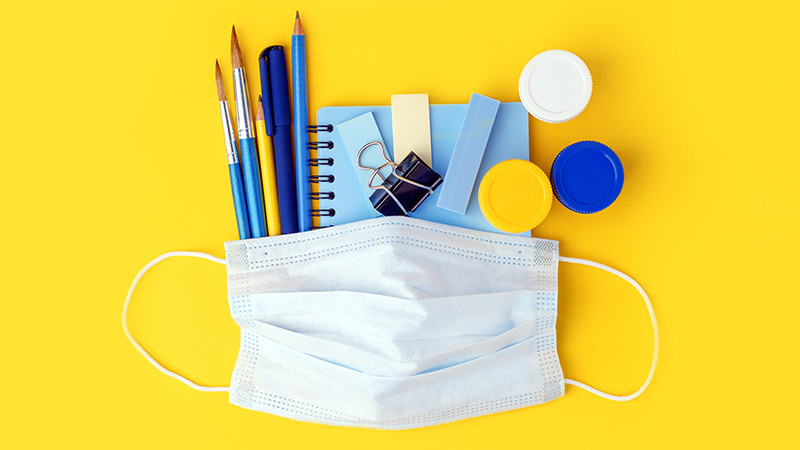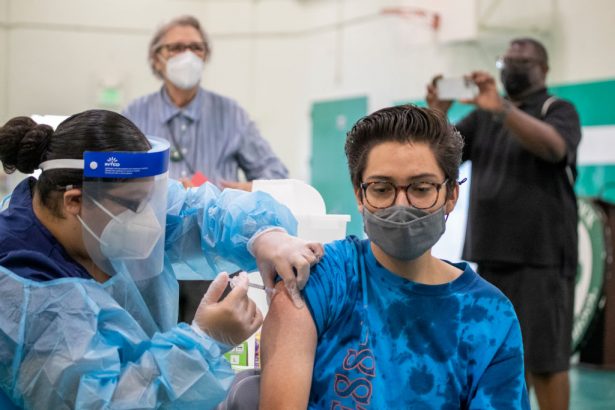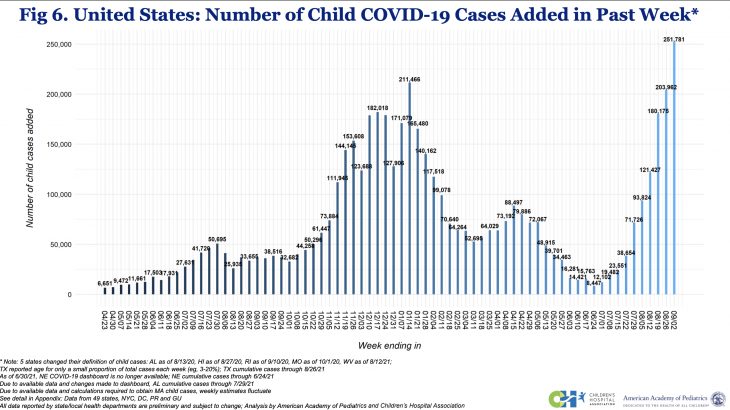The Week in COVID & Education Policy: Los Angeles to Require Shots for Students 12 and Up, Rising COVID Cases in Kids and 15 More Key Updates

This is our weekly briefing on how the pandemic is shaping schools and education policy, vetted, as always, by AEI Visiting Fellow John Bailey. Click here to see the full archive. Get this weekly roundup, as well as rolling daily updates, delivered straight to your inbox — sign up for The 74 Newsletter.
Los Angeles Unified to Require Vaccines for Eligible Students
- The school board for the nation’s second-largest district voted Thursday to require vaccinations for students 12 and older, Linda Jacobson reports in The 74.
- Students will need to receive their first dose by Nov. 21 and the second by Dec. 19 so they are fully immunized by the start of the second semester. Students participating in sports and other activities need to receive the second shot by Oct. 31.
- Exemptions for documented medical reasons will be allowed, according to the Los Angeles Times.
- In August, another Los Angeles County district, Culver City, announced a vaccine requirement for eligible students as well.

September 10, 2021 — THE BIG THREE
Why a COVID-19 Vaccine for Children Is Taking So Long: Really great piece by The Wall Street Journal
- “The logistical dance required to make doses safe for children is among the challenges confronting researchers evaluating the vaccines in the youngsters.”
- “Also complicating the trials, researchers said, federal health regulators demanded that more children be enrolled in the studies than originally planned. Enrolling children takes much longer than for adults because it requires parents’ consent, and some young volunteers don’t work out because they recoil at needles.”
- “Then, to assess whether the shots help, researchers said, they must gauge whether a child falls ill, no easy task with little ones who can’t always verbalize how they are feeling.”
Largest Increase in Pediatric COVID Cases Since Pandemic Began: State Data Report from American Academy of Pediatrics
- Nearly 252,000 children tested positive for COVID-19 last week, marking the largest increase of pediatric cases in a week since the pandemic began.
- “In states reporting, 0.00-0.03 percent of all child COVID-19 cases resulted in death.”
- Children represented about 15 percent of all cases reported, but in 13 states, at 18 percent or more cases were in children.
Meet the Overlooked: The movers, the missed, the muted: New Bellwether Education Partners report with the Walton Family Foundation.
- “11.3 million children lacked access to the learning options they needed during COVID-19,” according to the report. That spurred some families to change schools or disengage from the system, while others will continue to “grapple with unresponsive systems and limited choices this fall.”
- More via Axios: “Now, the total number of homeschooled kids sits at about 5 million. According to census data, more than 11 percent of U.S. households are now homeschooling.”
Federal Updates
Jill Biden: Op-ed in Time — A Tribute to Classroom Heroes
U.S. Education Department:
- New resource provides “Evidence-Based Strategies to Address Impact of Lost Instructional Time by Using American Rescue Plan Funding”
- The Department of Education’s Office for Civil Rights opens investigations in five states regarding prohibitions against universal indoor masking.
- “OCR is concerned that state mask restrictions on schools and school districts ‘may be preventing schools … from meeting their legal obligations not to discriminate based on disability and from providing an equal educational opportunity to students with disabilities who are at heightened risk of severe illness from COVID-19.’”
- Read more via The 74, The Washington Post and The New York Times.
Federal Communications Commission: 5 million households have signed up for the Emergency Broadband Benefit Program.
Two Top FDA Officials Resign:
- “Two of the FDA’s most senior vaccine leaders are exiting from their positions, raising fresh questions about the Biden administration and the way that it’s sidelined the FDA,” Endpoint News reports.
- Axios adds: “The FDA appears to be increasingly rudderless at a crucial time in the pandemic. The agency still has no permanent commissioner and now is losing two highly regarded vaccine experts all while officials weigh full approval of the COVID-19 vaccines for adults, initial authorization for kids and booster shots for many.”
City & State News
California:
- Quarantines and teacher shortages are a double whammy for California districts.
- Los Angeles County health officials will continue to enforce rigid school quarantine rules that are stricter than state guidelines and have raised concerns among some school leaders and parents about academic disruption after thousands of students and staff members were sent home in the opening days of the school year.
D.C.: How an afterschool program achieved a high vaccination rate in a Black neighborhood where most young adults are unvaccinated.
Florida: Florida judge rules to set aside stay, allowing mask mandates in schools.
Hawaii: Hawaii’s public school system is looking to the mainland for teachers to teach online classes as the islands struggle with a surge in COVID-19 cases.
Illinois:
- Governor announces vaccine mandate for teachers and health care workers with testing opt-out.
- Chicago Public Schools in talks with Uber, Lyft after bus drivers quit over vaccine mandate.
Mississippi: 15 percent of all students are in quarantine.
North Carolina: New law changes how school districts handle mask rules, school performance.
Ohio: Unvaccinated, unmasked students exposed to coronavirus could remain in class, under potential pilot project.
Texas: Cases tripled in the last three weeks. There are more than 51,000 student cases — up from the 18,000 recorded just two weeks ago. There are also more than 13,000 staff cases.
COVID-19 Research
COVID-19 Testing Is Keeping Some Students in School and Out of Quarantine: Via The Wall Street Journal
- “One pilot study, not yet peer-reviewed, found that daily rapid testing of school-related close contacts didn’t lead to a substantial increase in COVID-19 transmission compared with quarantine among students at some 160 schools and colleges. Less than 2 percent of close contacts who were exposed eventually tested positive.”
- “Health and education officials in states including Massachusetts and Illinois are leveraging existing testing infrastructure to offer frequent testing as an alternative to quarantine.”
In Britain, Young Children Don’t Wear Masks in School: Via The New York Times
- “The British handled the Delta spike in ways that might surprise American parents, educators and lawmakers: Masking was a limited part of the strategy. In fact, for the most part, elementary school students and their teachers did not wear them in classrooms at all.”
- “’The U.K. has always, from the beginning, emphasized they do not see a place for face coverings for children if it’s avoidable,’ said Dr. Shamez Ladhani, a pediatric infectious-disease specialist at St. George’s Hospital in London and an author of several government studies on the virus and schools.”
- “The potential harms exceed the potential benefits, he said, because seeing faces is ‘important for the social development and interaction between people.’”
- More via Chalkbeat: What we know about masks, students and COVID spread: A Chalkbeat guide
Unraveling the Mystery of Why Children Are Better Protected from COVID Than Adults: Via Scientific American.
CDC Study on a School Outbreak: An unvaccinated teacher who unmasked when reading aloud in class caught COVID-19 and spread it to half of the students in the classroom, according to a new study from the Centers for Disease Control and Prevention.
Student Vaccine Mandates: Dr. Anthony Fauci backs COVID-19 vaccine mandate for U.S. schoolchildren, Reuters reports. “I believe that mandating vaccines for children to appear in school is a good idea,” Fauci told CNN. “We’ve done this for decades and decades, requiring polio, measles, mumps, rubella, hepatitis [vaccinations].”
Pfizer Timeline for Children Vaccine: Clinical trial results in September for ages 5-11, potential FDA clearance late November, early December. Results for ages 2-5 in November.
Vaccination Rates Among 12-17 Year Olds: The CDC reports that as of July 31, coverage with at least one dose of a COVID-19 vaccine was 42 percent, and 32 percent had completed the series of shots. See the state-by-state data here.
Myocarditis Risk 37 Times Higher for Children with COVID-19 than Uninfected Peers: According to a new CDC study.
- “Across all ages, the risk of myocarditis was almost 16 times higher for people with COVID-19 compared to those who aren’t infected.”
- “The myocarditis risk is 37 times higher for infected children under 16 years and seven times higher for infected people ages 16-39 compared to their uninfected peers.”
Teachers Not at Increased Risk of Hospitalization: Study and summary in the journal BMJ
- “Teachers are about average in terms of their risk of hospitalization with COVID-19, when compared to other working-age adults,” said lead researcher Dr. David McAllister, a professor of clinical epidemiology and medical informatics at the Institute of Health and Wellbeing at the University of Glasgow. “Unlike health care workers, teachers are not at increased risk of hospitalization with COVID-19, even when schools are open.”
- “In schools where masks and social distancing are mandated, the risk of spreading COVID-19 is cut dramatically.”
Australian Study Finds Children Less Likely to Spread COVID-19 in Schools: A national research center examined 51 schools and child care centers that had COVID-19 cases since the beginning of the Delta outbreak from June 16 to July 31.
- Despite a fivefold increase in the spread of COVID-19 in the schools, only 2 percent of infected children required care in hospital.
- More via The Guardian. Read the study here.
Viewpoints
90,000 Students Have Had to Quarantine: Because of COVID-19 so far this school year.
Why Vaccine Mandates for Teachers Have Been a Harder Sell Than Mask Mandates: Kara Swisher interviews Randi Weingarten. (Read the transcript.)
A Third Disrupted Year Can Only Strain Americans’ Ties to Traditional Public Schools: Writes Robert Pondiscio for the Fordham Institute.
Pandemic Windfall for Schools Has Few Strings Attached: Via Associated Press.
- “Some districts will receive sums amounting to 50 percent or more of the cost to operate their schools for a year.”
- “Detroit received the highest rate among big districts, at more than $25,000 per student. It was followed by Philadelphia, with $13,000 per student, and Cleveland, at more than $12,000.”
How Schools Are Using American Rescue Plan Funding: Survey from AASA, the School Superintendents Association.
- 75 percent used funding for summer learning and enrichment offerings.
- 62 percent used funds to purchase technology/devices and/or provide students with internet connectivity
- 66 percent plan to use funding to add specialized instructional support staff and other specialists
- 52 percent plan to use funding to implement or advance social-emotional learning practices and systems in their districts and/or on trauma-informed training for their educators.
- 44 percent plan to provide high-intensity tutoring
- Related: Analysis of ARP spending from the Council of Chief State School Officers
‘Community Schools’ See Revival in Time of Heightened Need: Via US News
Best Practices for Data Sharing Between Schools and Afterschool Programs: From the Future of Privacy Forum
Push to Reopen Schools Leaves Many Quarantined Students Without Remote Learning Options: Via Linda Jacobson in The 74.
- “In many ways, schools in the Tampa area are facing the same remote learning challenges they did when schools first closed in 2020. Some don’t have internet access. Others only connect on their phones, and some parents can’t pick up paper copies of lessons at school because they’ve tested positive for COVID-19. Even if a student has a computer, teachers aren’t required to teach over Zoom due to an agreement with the local teachers union, said spokeswoman Erin Maloney.”
- “‘There was pretty much nothing offered to us — no Zoom, no live option at all,’ said Meredith Copley, whose children, ages 10 and 12, were quarantined last week.”
New COVID learning loss numbers from Ohio: Analysis of Spring 2021 Ohio State Tests
- “Pandemic-related declines in student achievement (from March 2020 to spring 2021) are roughly equivalent to students missing one-half to one full year’s worth of learning in math (students in later grades had greater declines) and between one-third and one-half of a year’s worth of learning in English language arts (depending on the grade).”
- “Districts with fully remote instruction experienced test scores declines up to three times greater than districts that had in-person instruction for the majority of the school year.”
- “In ELA, Black students saw their test scores decrease 2 to 3 times more than white students in most grades, while Hispanic students experienced declines that were typically twice as large as those of white students.”
Student Learning Pods — From Crisis Response to Sustainable Solution?: CRPE researchers in The 74
- “37 percent of all learning pods identified in the database operated through the full 2020-21 school year.”
- “Many of the learning pods that existed before the pandemic as afterschool programs or summer camps switched back to their pre-pandemic programming.”
- “But others continued on. Some, like the Equity Pods network, which supported culturally relevant community-based pods across the country for Black and brown students, finished out the school year even as districts in some locations opened for at least some of the year.”
… And on a Lighter Note
Hope everyone had a great Labor Day weekend: This dog got in some last-minute pool time.
@rileysgoldenlife #goldenretriever #goldenretrieverlife #golden #puppy #pup #puppylove #pool #poolday #chill #flamingo #floating #riley #puppiesoftiktok
ICYMI @The74
Weekend Reads: In case you missed them, our top five stories of the week:
- Education Politics: From Tragedy to Triumph to Failure: How 9/11 Helped Pass No Child Left Behind — And Fueled its Eventual Demise
- California Election: From Reopening Schools to Mask Mandates, Education Policy Expected to Play Key Role In Upcoming Newsom Recall Vote in California
- School Safety: How to Stop a School Shooter
- 74 Interview: NYC Principal Alice Hom Prepares for a Return to School After a Year of Heightened Anti-Asian Sentiment and COVID-19
Disclosure: John Bailey is an adviser to the Walton Family Foundation, which provides financial support to The 74.
Get stories like these delivered straight to your inbox. Sign up for The 74 Newsletter

;)

